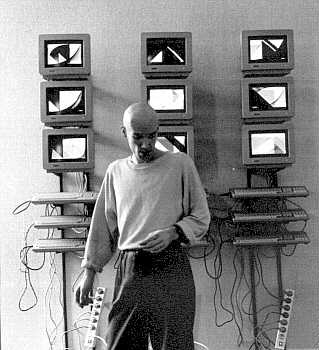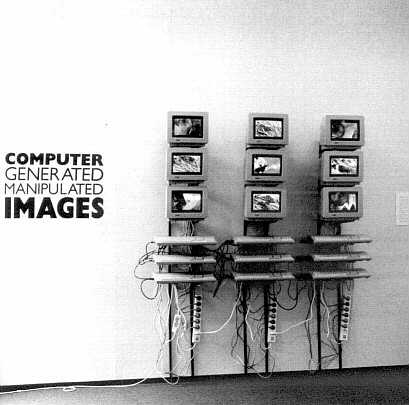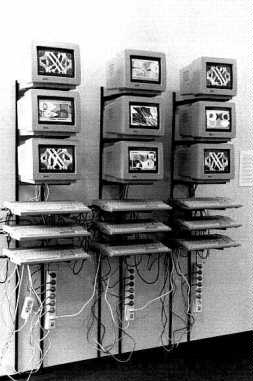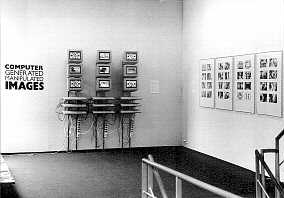Some backgrounds
Testing the Art Moderne Installation.


The 9 computers to set up the installation were sponsored by COMMEDIA Amsterdam and ATARI BENELUX. I received them at home 3 weeks before the exhibition would take place to test my software running with the 9 computers interconnected by MIDI and to compose the graphic 'symphony'.
The first problem that appeared was due to the fact that the computers were all new. When they were switched on, they filled the air with a dirty smell that made me dizzy within 1 hour. This made the programming quiet to be a hallucination.
Nevertheless it was very exciting to view the process of Auto Composing on 9 monitors at the same time. The maximum that I had so far were only 3 monitors. However each computer is running the same software, they all produce unique variations within each 'style frame' (algorithm). Within some styles the different results start to be close to each other and 'slowly' mutate towards something completely different. Some other styles produce great differences straight away. The more computers are running at the same time with the same algorithm, the more interesting it becomes to view the creating acts.

 Another problem that appears when presenting an installation like this, is the reliability
of both the hard and software. It must operate for weeks without errors and it must be
switched on each day by somebody that does not know about any technical details. The
computers needed to be switched on in groups of three each. Each computer then starts to
auto load its software and then waits for 20 second before its starts to send out some MIDI
codes. All computers are MIDI interconnected as a ring. This means that each code that is
send is received by the next computer in the ring and also seen by the software. The
software then sees whether this information needs to be used or to be send through to the
next computer - until it reaches its destination. This means that the codes that are send
do have ID information that determines the destination computer. But, when starting up non
of the computers know which ID they have. Also, one of the computers must act as a master
while the others must act as slaves to this master.
Another problem that appears when presenting an installation like this, is the reliability
of both the hard and software. It must operate for weeks without errors and it must be
switched on each day by somebody that does not know about any technical details. The
computers needed to be switched on in groups of three each. Each computer then starts to
auto load its software and then waits for 20 second before its starts to send out some MIDI
codes. All computers are MIDI interconnected as a ring. This means that each code that is
send is received by the next computer in the ring and also seen by the software. The
software then sees whether this information needs to be used or to be send through to the
next computer - until it reaches its destination. This means that the codes that are send
do have ID information that determines the destination computer. But, when starting up non
of the computers know which ID they have. Also, one of the computers must act as a master
while the others must act as slaves to this master.

 Because all nine computers have identical software, that does not say who the master is,
the MASTER FIGHT was invented. When the computers start up they are all equal and each of
them start to play a numeric random game. The results of this game are send to the next
computer in the ring. This one sends it also to the next one and so on. Thus, they all
know from each other which numbers they chose sequently. One number is the winning one
(this number is also randomly chosen by all of them and reduced to a single 'bingo card').
At a certain moment one computer has the bingo number and the others are seeing this and
thus decide to have their master chosen (when two computers have the bingo number at the
same time, they simply continue fighting with each other until one is left). At the end of
the game the master is known and the graphic 'symphony' can start.
Because all nine computers have identical software, that does not say who the master is,
the MASTER FIGHT was invented. When the computers start up they are all equal and each of
them start to play a numeric random game. The results of this game are send to the next
computer in the ring. This one sends it also to the next one and so on. Thus, they all
know from each other which numbers they chose sequently. One number is the winning one
(this number is also randomly chosen by all of them and reduced to a single 'bingo card').
At a certain moment one computer has the bingo number and the others are seeing this and
thus decide to have their master chosen (when two computers have the bingo number at the
same time, they simply continue fighting with each other until one is left). At the end of
the game the master is known and the graphic 'symphony' can start.
The progression in the 'Master fight' also is visualized on the monitors. The screens
are vibrating by varying the vertical size of a white band across the screen as an
translation of the numerical values that the software chooses. Although simple, it creates
a living view on the installation.
The system of interconnecting all computers as a ring has the advantage that (together
with its software implementation) the amount of computers may vary to any amount. The
'Master fight' protocol also finds out how many computers are connected. When a computer
does not respond to incoming information after a certain time out and several retries, it
switches to an individual mode to act as a STAND ALONE device and thus is not a member
anymore of the Master/Slave team. This also could happen because the connection wiring
does not function or one computer has dropped out.



